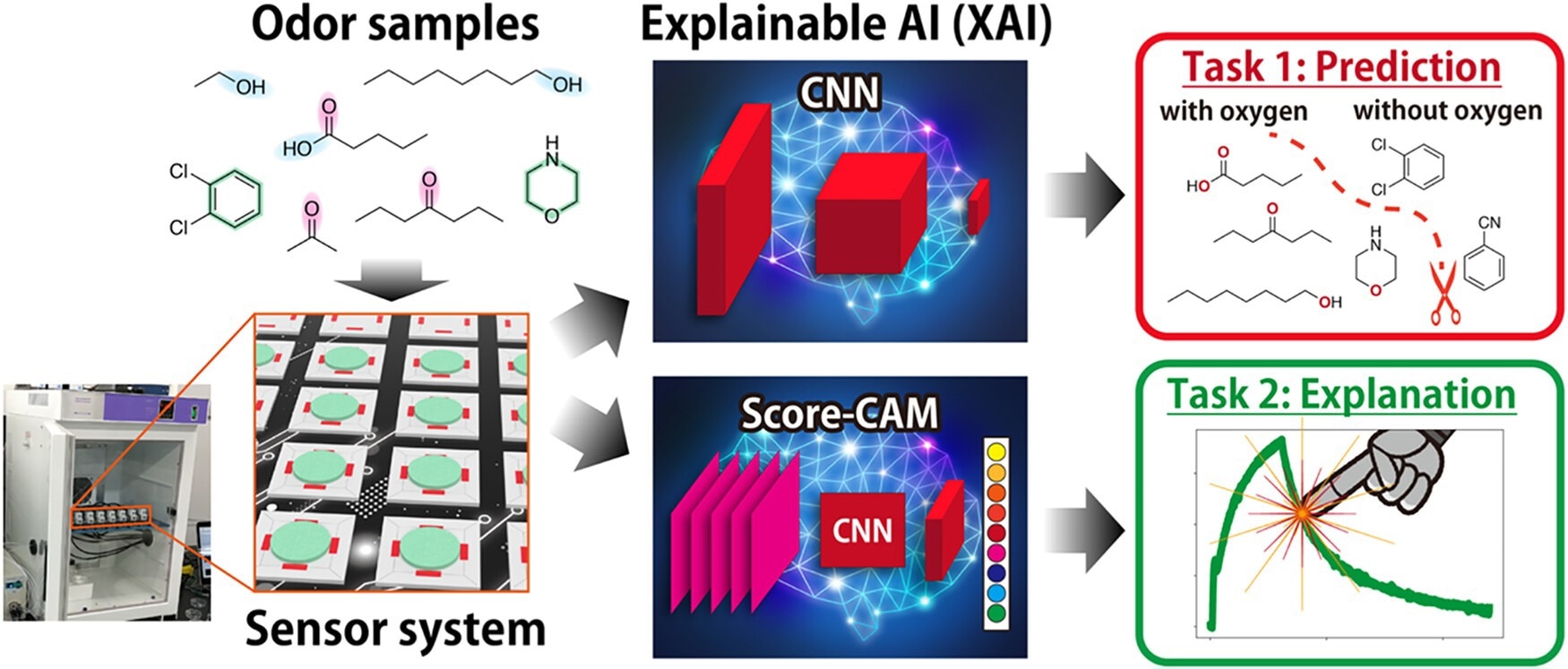By applying explainable AI to chemical sensor data, NIMS scientists have decoded how receptor materials detect specific odor molecules, thereby advancing artificial olfaction performance and providing insights into the biological basis of smell.

Flowchart of the signal analysis based on XAI for predicting the category of samples and understanding the important parts of the signals.
NIMS has been developing chemical sensors as a key component of artificial olfaction technology (olfactory sensors), with the aim of putting this technology into practical use. In this study, explainable AI (XAI) was employed to elucidate how chemical sensors distinguish among various odorant molecules.
The findings may help guide the selection of receptor materials for developing high-performance chemical sensors that can detect odorant molecules. The achievement is expected not only to improve the performance of artificial olfaction but also to advance understanding of human olfactory mechanisms.
This research was published online in the journal ACS Applied Materials & Interfaces.
Understanding the role of smell and artificial olfaction
The sense of smell plays an essential role in daily life, influencing food safety, environmental monitoring, medical diagnosis, and the creation of comfortable living environments. Artificial olfaction technologies, also known as olfactory sensors, mimic the human sense of smell by using multiple chemical sensors to detect odorant molecules and applying artificial intelligence (AI) to classify and identify them.
However, AI-assisted artificial olfaction has yet to reach widespread application due to the limited sensitivity and discrimination accuracy of existing chemical sensors. Addressing these limitations requires higher-performance sensors, particularly through the design of receptor materials that can more effectively interact with odorant molecules.
Need for receptor-specific insights in AI-based olfaction
In conventional artificial olfaction systems, AI classifies odorant molecules without clear knowledge of which receptor materials respond to specific compounds. Understanding the response characteristics of individual receptor materials enables the development of optimal combinations for discriminating target odorants and selecting materials that improve odor classification accuracy.
Explaining how AI interprets chemical sensor data
NIMS researchers measured the responses of 94 odorant molecules using a membrane-type surface stress sensor (MSS) equipped with 14 receptor materials and analyzed the data using explainable AI (XAI). This approach visualizes which aspects of the data the AI uses to distinguish among odorant molecules.
The analysis revealed that the most influential parts of the sensor responses vary depending on the combinations of odorant molecules and receptor materials. For instance, receptor materials containing aromatic rings played a key role in identifying aromatic compounds. This discovery highlights how XAI can reveal the specific sensor-odorant interactions underlying AI predictions.
XAI-guided selection of high-performance receptor materials
This method enables the more efficient selection of receptor materials tailored to specific target odorants, supporting the development of sensors capable of identifying molecules that are otherwise challenging to detect. Furthermore, by revealing both how AI discriminates and the reasoning behind its predictions, XAI offers valuable insights into the fundamental mechanisms of odor detection and, potentially, human olfactory perception.
Applications and implications for sensor design
This technology has broad applications beyond material discovery. It can be used to select the most appropriate sensor type for different purposes, optimizing detection performance across various environments and industries. By supporting the development of receptor materials and sensor selection, the approach will accelerate the practical implementation of artificial olfaction and contribute to a deeper scientific understanding of smell.
Research team and publication details
- This project was conducted by Yota Fukui (Trainee, Center for Basic Research on Materials (CBRM), NIMS at the time of this project), Koji Tsuda (Invited Researcher, CBRM, NIMS), Ryo Tamura (Team Leader, CBRM, NIMS), Kosuke Minami (Principal Researcher, Research Center for Macromolecules and Biomaterials (RCMB), NIMS), and Genki Yoshikawa (Group Leader, RCMB, NIMS).
- The research was published online in ACS Applied Materials & Interfaces on September 9, 2025.
Source:
Journal reference:
- Harnessing Explainable AI to Explore Structure–Activity Relationships in Artificial Olfaction, Yota Fukui, Kosuke Minami, Genki Yoshikawa, Koji Tsuda, and Ryo Tamura, ACS Applied Materials & Interfaces 2025 17 (37), 52728-52737, DOI: 10.1021/acsami.5c13990, https://pubs.acs.org/doi/full/10.1021/acsami.5c13990